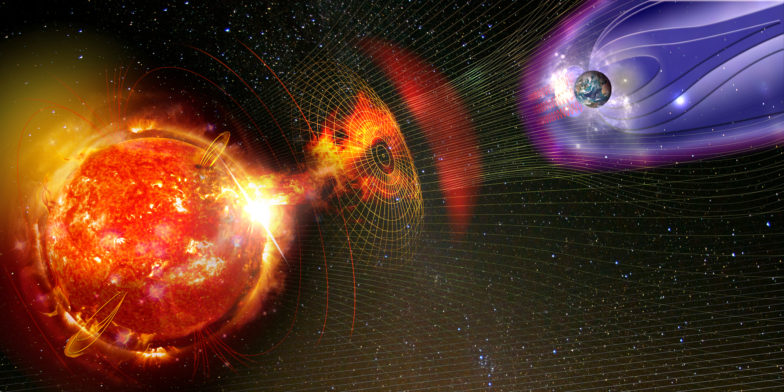Polarization of Cosmic Microwave Background
Today the scientific evidence for the biblically predicted big bang creation model1 is both overwhelming and compelling. In fact, so much evidence has accumulated that astronomers have been able to identify a very specific cosmic creation model that simultaneously explains the origin, history, and design of the universe. This creation model is the ΛCDM big bang model, otherwise known as the standard cosmological model. (The ΛCDM stands for a hot big bang universe that is dominated primarily by dark energy and secondarily by cold exotic dark matter, where the particles making up the exotic dark matter are moving at low velocities relative to the velocity of light.)
In spite of the surpassing success of the ΛCDM model a handful of atheists and young-earth creationists still dispute the scientific evidence in favor of these models. Though their numbers are small, they are very vocal and still wield considerable influence over their respective constituencies. This reason alone justifies the search for yet more scientific evidence in support of the ΛCDM models. And, if these models can demonstrate successful confirmation of yet another risky prediction, that advance would be most effective.
Such a success has now been achieved thanks to the efforts of an international team of 31 astronomers known as the QUaD Collaboration.2 The QUaD experiment is a multi-year program designed to measure the polarization of the cosmic microwave background (CMB) radiation left over from the big bang. The researchers used a submillimeter wavelength telescope located at the South Pole (see photo-image below).
[A photograph of the QUaD telescope inside its groundshield taken from a crane above the telescope (released into the public domain by its author, rfriedman81).]
In technical terms, the ΛCDM model predicts that the CMB radiation will be polarized at approximately the 10 percent level due to the motions of cosmic material at very early moments after the creation event. Given the ΛCDM model fit to the temperature spectrum of the CMB radiation, two polarization modes are deterministically predicted. These modes are the E-mode spectrum (EE) and the temperature-E mode cross spectrum (TE). The important points here are that the quantities and the geographical locations of dark energy and dark matter provide strong circumstantial evidence for the ΛCDM model. Meanwhile, confirmation of the predicted EE and TE spectra would provide a proof for the overall theoretical ΛCDM paradigm.
The QUaD experiment is not the only one to detect the predicted EE and TE spectra. Five other CMB radiation detectors also have found them.3 Thus far, all the reported measurements of the EE and TE spectra are consistent with the ΛCDM model. The QUaD Collaboration detected the predicted acoustic peaks in the EE spectrum for the first time with high significance. The positions and levels of the peaks proved to be consistent with what the ΛCDM model predicted. In the words of the QUaD Collaboration team, “the standard cosmological model has passed yet another stringent test.”4
New observations continually and consistently provide increasingly stronger proofs for a big bang creation event. In this context the biblically predicted big bang creation model and the biblical Creator have passed yet another scientific test.
Endnotes
-
Hugh Ross, The Creator and the Cosmos, 3rd ed. (Colorado Springs: NavPress, 2001), 23-29.
-
C. Pryke et al., “Second and Third Season QUaD Cosmic Microwave Background Temperature and Polarization Power Spectra,” Astrophysical Journal 692 (February 20, 2009): 1247-70.
-
C. Bischoff et al., “New Measurements of Fine-Scale CMB Polarization Power Spectra from CAPMAP at Both 40 and 90 GHz,” Astrophysical Journal 684 (September 10, 2008): 771-89; T. E. Mountroy et al., “A Measurement of the CMB (EE) Spectrum from the 2003 Flight of BOOMERANG,” Astrophysical Journal 647 (August 20, 2006): 813-22; J. L. Sievers et al., “Implications of the Cosmic Background Imager Polarization Data,” Astrophysical Journal 660 (May 10, 2007): 976-87; D. Barkats et al., “First Measurements of the Polarization of the Cosmic Microwave Background Radiation at Small Angular Scales from CAPMAP,” Astrophysical Journal Letters 619 (February 1, 2005): L127-L130; M±. R. Nolta et al., “Five-Year Wilkinson Microwave Anisotropy Probe Observations: Angular Power Spectra,” Astrophysical Journal Supplement 180 (February 2009): 296-305; L. Page et al., “Three-Year Wilkinson Microwave Anisotropy Probe (WMAP) Observations: Polarization Analysis,” Astrophysical Journal Supplement 170 (June 2007): 335-76; J. M. Kovac et al., “Detection of Polarization in the Cosmic Microwave Background Using DASI,” Nature 420 (December 19, 2002): 772-87; A. C. S. Readhead et al., “Polarization Observations with the Cosmic Background Imager,” Science 306 (October 29, 2004): 836-44.
- C. Pryke et al., 1270.






